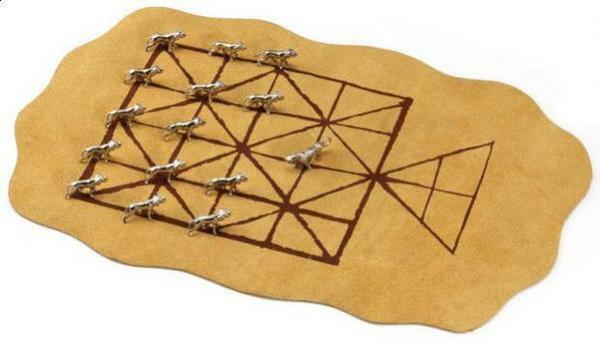Indigenous games are those inherited from the cultures developed by the different groups of Indians in Brazil.
They represent indigenous games and games that were created in the tribes for entertainment, especially for children. Generally, people themselves make the toys used in some of these games.
Many of these games and games are already part of our childhood and can be used in early childhood education in order to awaken the feeling of collectivity, companionship, cooperation, in addition to skills such as coordination, balance and a sense of strategy.
1. shuttlecock
- Toy used: shuttlecock
- Number of participants: 2 at least
- Objective: don't let the shuttle fall to the ground
The shuttlecock is a very popular toy made from sand, leather and feathers. The shuttlecock game contributes a lot to the fun and can be played between two or more children. To make it easier, a wheel can be formed.
The objective is to touch the shuttlecock and not let it fall to the ground. If that happens, the person who dropped it is out of the game. Thus, whoever can touch and doesn't drop to the ground during the match wins.
To increase the fun, the shuttlecock can be made by the students themselves and is at the discretion of the teacher the materials to be used and which can be: newspaper, sand, small stones, colored fabrics and string.
2. Tug of war
- Materials used: long, reinforced rope; chalk to scratch the floor.
- Number of participants: 2 at least
- Objective: Pull the rope hard to the side that is on
Very popular with children, to play tug of war you have to divide the number of participants evenly. A scratch is made on the floor and each group holds the rope to one side.
When you start, the idea is to make your opponents go over the floor line. To do this, a lot of force is used to pull the rope. The winning group is the one that managed to pull with the greatest strength and bring the group of opponents closer.
3. Pluck cassava
- Material used: none
- Number of participants: 2 at least
- Objective: cassava (hold the tree tightly so that it is not uprooted); for cassava rips (remove each one from the game)
For the cassava ripping game no object is needed, although it is necessary to have a tree nearby to start the fun. Thus, sitting on the ground, the first child holds the tree and the others fit in and hold the colleague in front.
A child is chosen to stand and named the “cassava harvester”. The idea is to “pull” each one out, until the child who is holding the other, releases the hands of the person in front. The objective is to try to remove everyone and, for that, one by one removes from the queue.
4. Bow and arrow
- Materials used: bow and arrow; target
- Number of participants: 2 at least
- Objective: Try to hit the target as many times as possible
Archery is a very fun game that stimulates children's coordination. First, place the target at a reasonable distance (and this will depend on the age of the children) and one person at a time will try to hit the center, which will be worth more points.
You can make rounds of three moves and whoever manages to hit an arrow closest to the center of the target, wins. If they do not have the objects to play the game, the children themselves, with the help of the teachers, can cut out a cardboard in the shape of a circle, indicating the center with a pen. To replace the bow and arrow, you can make colored balls to try to hit the target.
5. Hawk and birds
- Materials used: chalk to draw
- Number of participants: at least 3
- Objective: for the birds (try not to get caught by the hawk); to the hawk (catch the birds)
First, a large tree is drawn on the ground with branches matching the number of participants. Each will be on a branch and a child is chosen to be the hawk.
When the game starts, each bird will make a flapping movement, and may also sing and whistle in order to distract the hawk. The hawk, on the other hand, will be on the lookout to catch every bird that is off the branch.
Therefore, the ideal is to be aware of the proximity of the hawk and the location of its branch. Each child caught by the hawk leaves out of the game until only one child is left, the winner.
6. jaguar game
- Materials used: game board; cardboard, pen and ruler for making the board; pebbles, buttons or caps.
- Number of participants: 2 players
- Objectives: corner the jaguar (for dogs); attack 5 dogs (for the jaguar)
The jaguar game, also called adugo, is a very interesting game to stimulate children's sense of strategy. The board can be purchased, but also made or designed on the floor. The shape of the board is a square divided into 16 equal parts and a triangle connected to it.

14 identical stones and a different one (which will be the jaguar) are used. The fourteen represent the dogs and the different stone is the jaguar. The dogs aim to corner the jaguar before it attacks. If 5 dogs are caught by the jaguar, it wins the game.
7. Saci race
- Material used: none.
- Number of participants: 2 at least
- Objectives: reach the finish line
Saci running is a very fun game that stimulates coordination and balance. It can be done with a large group of children in an outdoor space such as a patio.
Related to the most famous character in our folklore, the saci, the race is done with one leg. A line is drawn with chalk or even on the sand to indicate the finish, and another, the departure.
Thus, all players remain behind the starting line. When the signal is given, everyone must run with one leg to the finish line. If both feet are used at some point in the race, the player is out of play. The winner is whoever can reach the other side first with one leg.
8. Tobdah
- Material used: shuttlecocks
- Number of participants: 4, minimum
- Objectives: hit opponents with shuttlecock
Very similar to our dodgeball game, Tobdaé is a game played in pairs (but they can be with more children divided into two groups) and aims to hit someone from the opposing team with the shuttlecock. It can be developed on a court, or even outdoors.
Whoever is hit, goes out of the game and thus, wins whoever remains until the end without being hit by the opponent's shuttlecock.
Generally, each player receives three shuttlecocks that will be used to hit someone on the opposing team. It is a very dynamic game that stimulates, above all, the sense of reflex, as many shuttlecocks are in play.
9. Cabas-Maë
- Material used: none
- Number of participants: 4, minimum
- Objectives: of the brushcutters (do not touch the heads and run from them); of the gourds (pick up the running brushes)
This is a very popular game among the indigenous tribes of the Amazon. To start with, all children are divided into two groups. One of them will represent the brushcutters, who take care of the garden, and the other, the cabas, which are species of hornets' nests.
Thus, the children representing the cabas form a wheel and sit in front of the others holding hands. They go on singing and waving their hands up and down, while the other group is responsible for moving their hands as if they were working in the fields.
Little by little, they get closer to the others and, the moment one of them touches a child representing the gourds, the brushcutters run, while the gourds aim to catch them.
10. Sun and moon
- Material used: none
- Number of participants: 6 at least
- Objectives: to be able to pull the opposing child
Sun and Moon is a game in which two children are chosen to represent the sun, and another, the moon. The other children form a line and, holding the waist of the one in front of them, they go under the arms, which are in the shape of a bridge, of the sun and moon children.
They all sing together and those who are stuck on the bridge must choose whether they want to stay with the moon or the sun. Thus, this child is at the side of the chosen group, until all the children make the choice.
After that, two groups are formed, the sun and the moon. In two rows, facing each other, the children of each group hold hands and try to pull the opposing child. The group that manages to make the most points by knocking down the elements of the other team will win.
11. watermelon
- Material used: none
- Number of participants: 6 at least
- Objectives: for watermelons (not being caught by thieves); to the owner (getting to catch the thief); for the thief (running away from the owner and his dogs)
In this game, a group of children will represent the watermelons and, therefore, they will be crouched with their heads down. They will be scattered across the land. One of them will be chosen to represent the owner of the plantation, responsible for taking care of their fruit. This child must be accompanied by two more, who will represent the plantation owner's dogs.
These animals help you keep watch over the watermelon field. In turn, another group will represent the thieves who will be responsible for trying to steal the fruit without the owner noticing. If the owner or the dogs have caught one of the thieves trying to steal the watermelons, they will run after him.
See also more games to play with children:
- Popular games that teach and kids love
- Wheel games
- Folk Plays
- June games


